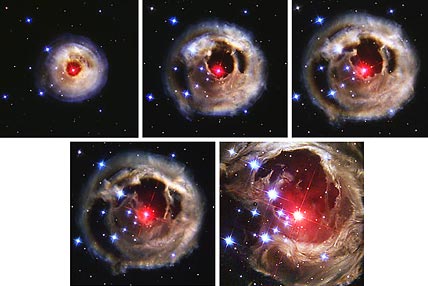Due to the vast distances separating deep-sky objects from Earth, few show obvious changes on scales shorter than a human lifetime. But there are exceptions.

The Hubble Space Telescope”™s Advanced Camera for Surveys captured these images (approximately true color) of the expanding light echo around V838 Monoc-erotis. We see an expanding pulse of light from the early-2002 outburst reflecting off nearly motionless dust clouds and shells.
When stars explode or flair, their energy and/or cast-off material can create changes visible thousands of light-years away. For instance, the star V838 Monocerotis flared in 2002. The flash is lighting up a surrounding cloud of gas and dust, giving the appearance of a ring of material expanding at the speed of light. See a discussion of this "light-echo" effect here.
In the case of V838 Mon, it's just the light — the "flash front" — that's expanding; the lit-up material is actually standing still (more or less). Not so with supernovae, which are so energetic that they expel their outer layers at a good percentage of the speed of light.
The Crab Nebula, discussed on page 31 of SkyWatch 2012, is a good example. It's the cast-off material from a supernova seen in 1054. It has been photographed now for almost 10% of its entire life, and not surprisingly, it has expanded quite a bit over that period. See, for instance, this Astronomy Picture of the Day. The Chandra X-ray telescope has also produced some time-lapse videos of matter swirling furiously around the neutron star at the heart of the Crab.
Click here to find other videos and images for SkyWatch 2012.
 0
0
Comments
You must be logged in to post a comment.